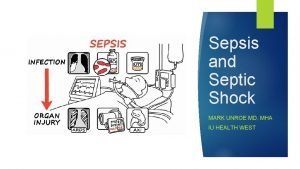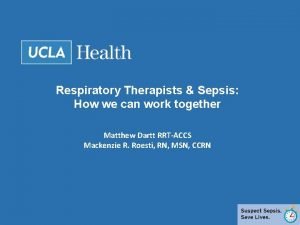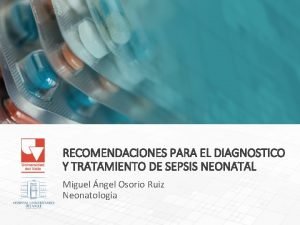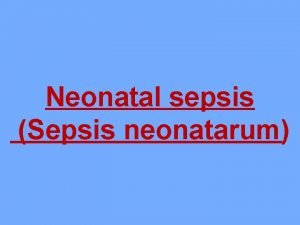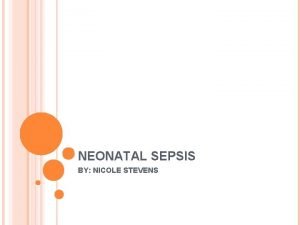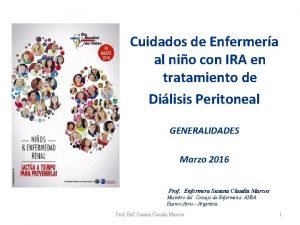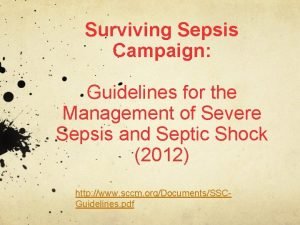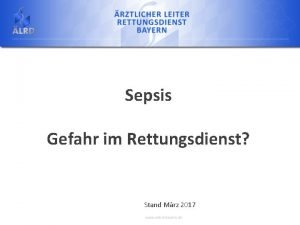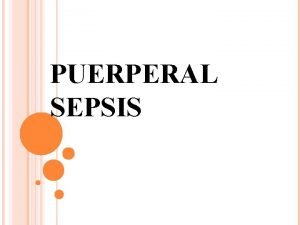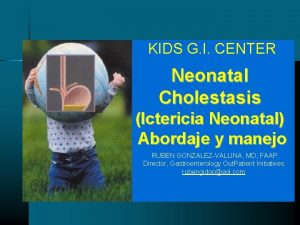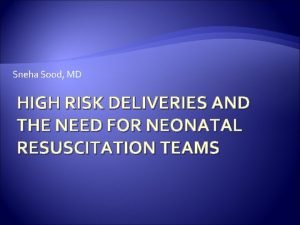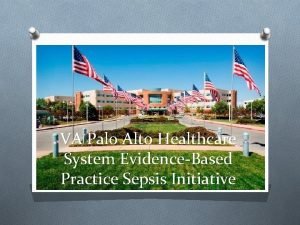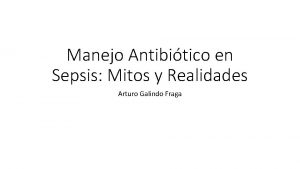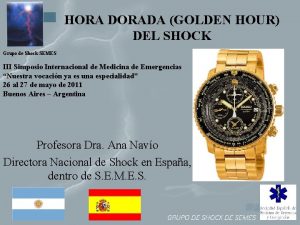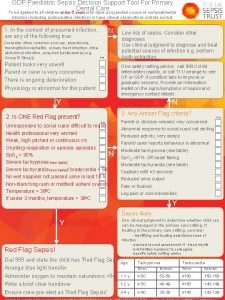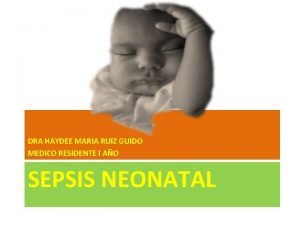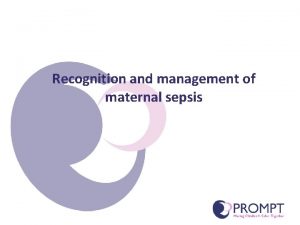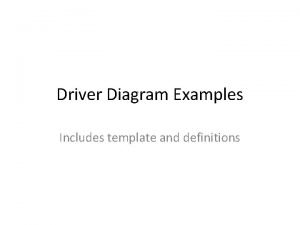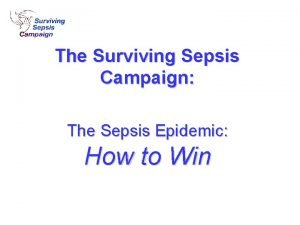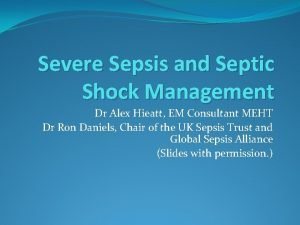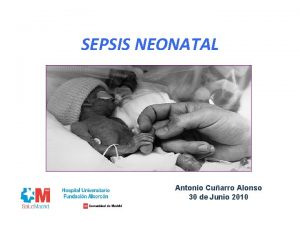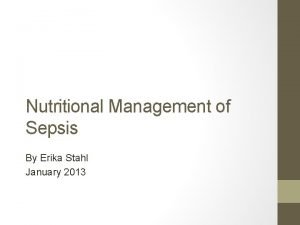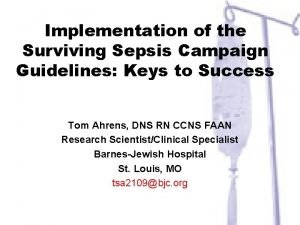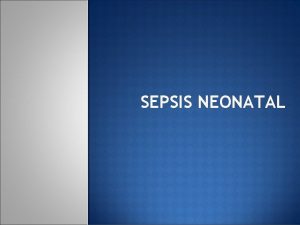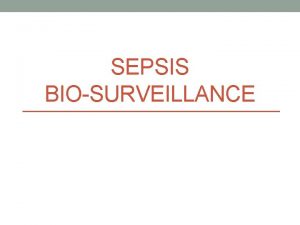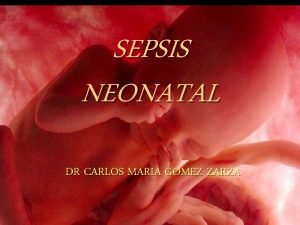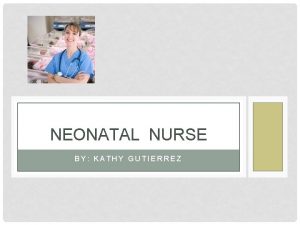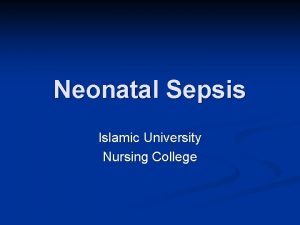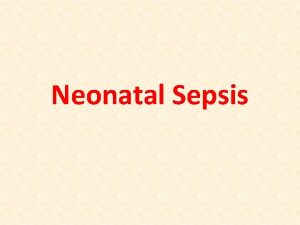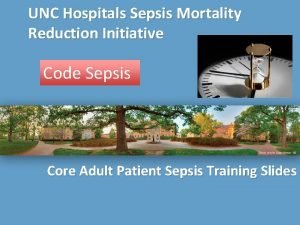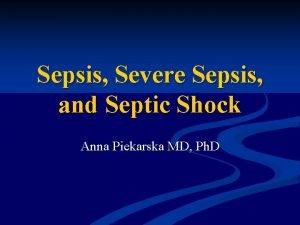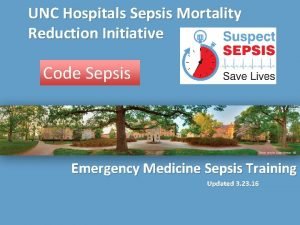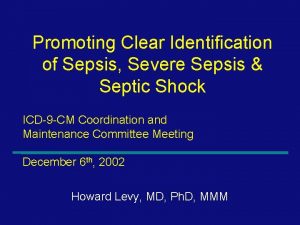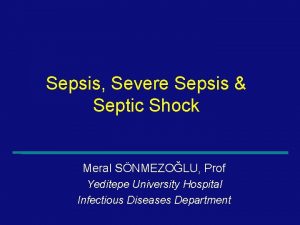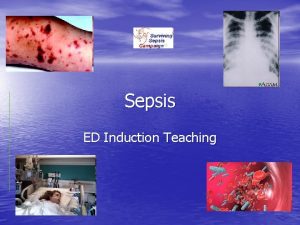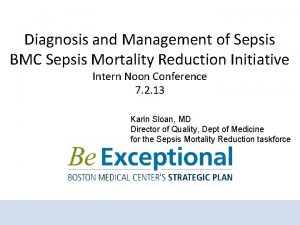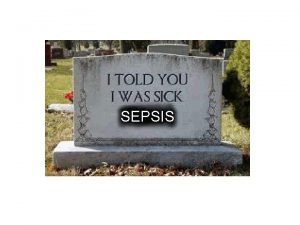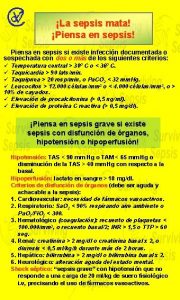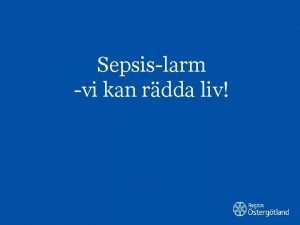Neonatal sepsis Neonatal sepsis Definition Neonatal sepsis is


























- Slides: 26

Neonatal sepsis.

Neonatal sepsis Definition : Neonatal sepsis is defined as a clinical syndrome of bacteremia with systemic signs and symptoms of infection in the first 4 weeks of life. When pathogenic bacteria gain access into the blood stream, they may cause infection: - without localization (septicemia) or - localized to the lung (pneumonia) or - localised to the meninges (meningitis).

Importance – Neonatal sepsis is the single most important cause of neonatal deaths in the community – If diagnosed early and treated aggressively with antibiotics and good supportive care, it is possible to save most cases of neonatal sepsis.

Etiology – Caused by Escherichia coli and Staphylococcus aureus. – In hospitals, Klebsiella pneumoniae (common ) – Group B streptococcus (early – onset )

Early vs. late sepsis classified into two sub-types : – If the onset of symptoms is before 72 hours of life (early onset) or later (late onset). - Early-onset infections are caused by organisms prevalent in the maternal genital tract or in the delivery area (prolonged rupture of membranes, foul smelling liquor, multiple per vaginum examinations, maternal fever, ) – difficult or prolonged labour and aspiration of meconium. – Early onset sepsis manifests as pneumonia and less commonly as septicemia or meningitis

. • Late-onset septicemia is caused by the organisms thriving in the external environment of the home or the hospital. onset of symptoms : • beyond 72 hours after birth and • Manifests septicemia pneumonia or meningitis, . • late-onset sepsis include: - low birth weight, lack of breastfeeding, superficial infections (umbilical sepsis), aspiration of feeds, disruption of skin integrity with needle pricks and use of intravenous fluids. • These factors enhance the chances of entry of organisms into the blood stream of the neonates whose immune defences are poor as compared to older children and adults

Clinical features Most common and characteristic manifestation : - an alteration in the established feeding behavior in late onset sepsis and - respiratory distress in early onset sepsis. - The baby, who had been active and sucking well, gradually or suddenly, becomes lethargic, inactive or unresponsive and refuses to suckle. - Hypothermia is a common manifestation of sepsis. - Diarrhea, vomiting and abdominal distension may occur. - Episodes of apneic spells or gasping may be the only manifestation of septicemia. - In sick neonates, the skin may become tight giving a hide -bound feel (sclerema) and the perfusion becomes poor (capillary refill time of over 3 seconds). - Cyanosis may appear. - A critical neonate may develop shock, bleeding and renal failure

Clinical manifestations • General : • • • Lethargy Refusal to suckle Poor cry • • • CNS : Not arousable, comatosed Seizures + High pitched cry + Excessive crying/irritability + Neck retraction + • • Bulging frontanel + Poor neonatal reflexes • • • Respiratory : Cyanosis * Tachypnea * Chest retractions * Grunt * Apnea/gasping * Hypotension : Poor perfusion Shock G. I Distension abdomen diarrhea Vomiting Temperature problems Hypothermia Fever + Others : Sclerema Bleeding Poor weight gain Blank look + Renal failure • * Particularly suggestive of pneumonia • + Particularly suggestive of meningitis

. • Evidence of pneumonia includes : tachypnea, chest retractions, grunting, early cyanosis , apneic spells and poor feeding. • Evidence of Meningitis includes : appearance of excessive or high-pitched crying, fever, seizures, blank look, neck retraction or bulging anterior fontanel are highly suggestive of meningitis.

According to WHO study (2003) : • identified nine clinical features suggestive for severe bacterial illness in young infants : 1. Feeding ability reduced 2. No spontaneous movement 3. Temperature >38 C 4. Prolonged capillary refill time 5. Lower chest wall in drawing 6. Resp rate > 60/minute 7. Grunting 8. Cyanosis 9. H/o of convulsions

Tests may include the following • Complete blood count • Cultures of: – Blood – Urine – Cerebrospinal fluid – Skin lesions • X-rays of the chest or abdomen

Diagnosis Direct method • from blood, CSF, urine, pleural fluid or pus is diagnostic. Indirect method • most useful and widely used is the white blood cell count and differential count. • neutrophilia (< 1800 per cmm) • Platelet count of less than 100, 000 per cmm, • ESR may be elevated

Cont. . • If possible, lumbar puncture should be done in all cases of late onset (>72 hours) and symptomatic early onset sepsis because 10 -15 percent of them may have associated meningitis. • The implications of detecting meningitis in the setting of septicemia include: the need for using antibiotics with a high CSF penetration and provision of antibiotic treatment for at least 3 weeks, administered parenterally throughout

Treatment • No investigation is required to start treatment in a clinically obvious case. Early treatment is crucial. • Supportive care and antibiotics are two equally important components of the treatment. • Antibiotics take at least 12 to 24 hours to show any effect and it is the supportive care that makes the difference between life and death early in the hospital course

Supportive care • purpose of supportive care is to normalize the temperature, stabilize the cardiopulmonary status, correct hypoglycemia and prevent bleeding tendency. • If hypothermic, the temperature should be raised using a heat source. An intravenous line should be established. • If perfusion is poor as indicated by a capillary refill time of more than 3 seconds, ( normal saline bolus should be infused) • A dextrose bolus will help correct hypoglycemia which is often present in septic infants. • Vitamin K should be given to prevent bleeding. • Oxygen should be provided if the infant is having retractions, grunt or cyanosis. Apneic neonates should be given physical stimulation and bag-mask ventilation, if required. • In neonates with sclerema, exchange transfusion with fresh whole blood may be contemplated.

Supportive care of a septic neonate 1. Provide warmth, 2. Start intravenous line. 3. Infuse normal saline 10 ml/kg over 5 -10 minutes, if perfusion is poor as evidenced by capillary refill time (CRT) of more than 3 seconds. Repeat the same dose 1 -2 times over the next 30 -45 minutes, if perfusion continues to be poor. 4. Infuse glucose (10 percent) 2 ml/kg stat. 5. Inject Vitamin K 1 mg intramuscularly. 6. Start oxygen by mask, if cyanosed or grunting. 7. Provide gentle physical stimulation, if apneic. 8. Provide bag and mask ventilation with oxygen if breathing is inadequate. 9. Avoid enteral feed if very sick, give maintenance fluids intravenously 10. Consider use of dopamine if perfusion is persistently poor. 11. Consider exchange transfusion if there is sclerema.

Antibiotic therapy • Antibiotic therapy should cover the common causative bacteria, namely, Escherichia coli, Staphylococcus aureus and Klebsiella pneumoniae. • A combination of ampicillin and gentamicin is recommended for treatment of sepsis and pneumonia. • In cases of suspected meningitis, cefotaxime should be used along with an aminoglycoside.

Antibiotic therapy of neonatal sepsis Antibiotic Each dose Frequency Route Duration <7 days age > 7 days age • I. Septicemia or Pneumonia • Inj Ampicillin or 50 mg/kg/dose 12 hrly 8 hrly • Inj cloxacillin 50 mg/kg/ dose 12 hrly 8 hrly IV • AND • Inj Gentamicin or 2. 5 mg/kg/dose 12 hrly 8 hrly IV, IM 7 -10 days • Inj Amikacin 7. 5 mg/kg/dose 12 hrly IV, IM 7 -10 days

II. Meningitis • Antibiotic • • (1) Each dose Frequency Route Duration <7 days age > 7 days age Inj Ampicillin 100 mg/kg/ dose 12 hrly 8 hrly IV 3 weeks • OR • (2) Inj Cefotaxime 50 mg/kg/ dose 12 hrly 8 hrly IV 3 weeks and Inj Gentamicin 2. 5 mg/ kg/dose 12 hrly and Inj Gentamicin 3 weeks 2. 5 mg/kg/ dose 12 hrly 8 hrly IV

Cont. • In late-onset sepsis to cover nosocomial staphylococcal infection, first line of antibiotics may comprise of cloxacillin 100 mg per kg per day and an aminoglycoside (gentamicin or amikacin). • Usually staphylococci and Gram negative bacilli (Pseudomonas, Klebsiella) should be covered using aminoglycoside (gentamicin or amikacin) and a third generation cephalosporin (cefotaxime). • For resistant staphylococcal infection, vancomycin (30 mg per kg per day) should be used. • On confirmation of sensitivity pattern, appropriate antibiotics are used singly or in combination. In a baby in whom the antibiotics were started on low suspicion, these may be stopped after 3 days, if baby is clinically well and the culture is negative. • if a baby appears ill even though the cultures are negative, antibiotic therapy should be continued for 7 to 10 days as bacterial infection can occur with negative cultures. • 7 -10 days therapy is required for pneumonia. • meningitis may require therapy for 3 -6 weeks

Superficial infections • Treated with local application of antimicrobial agents. • Pustules can be punctured with sterile needles and cleaned with spirit or betadine. • Purulent conjunctivitis can be treated with neosporin or chloramphenicol ophthalmic drops. Oral thrush responds to local application of clotrimazole or nystatin (200, 000 units per ml) and hygienic precautions. • Superficial infections must be adequately managed; if neglected they can lead to sepsis.

Prevention of infections • A good antenatal care goes a long way in decreasing the incidence, morbidity and mortality from neonatal sepsis. • All mothers should be immunized against tetanus. • All types of infections should be diagnosed early and treated vigorously in pregnant mothers. • Babies should be fed early and exclusively with expressed breast milk (or breastfed) without any prelacteal feeds. • Cord should be kept clean and dry. • Unnecessary interventions should be avoided

Hand washing • This is the simplest and the most effective method for control of infection in the hospital. All persons taking care of the baby should strictly follow hand washing policies before touching any baby. The sleeves should be rolled above the elbows. Rings, watches and jewellery should be removed. • Wash hands up to elbows with a thorough scrub for 2 minutes with soap. Rinse thoroughly with running water. Dry hands with sterile hand towel/paper towel. Wash hands up to the wrist for 20 seconds in between patients. Hands should be rewashed after touching contaminated material like one’s face, hair, papers etc. • In emergency situations bactericidal and virucidal solutions like Sterillium can be used to clean hands before touching babies.

Prevention of infection in hospital – The nursery environment should be clean and dry with 24 hour water supply and electricity. There should be adequate ventilation and lighting. The nursery temperature should be maintained between 30+2°C. Overcrowding should be avoided. – All procedures should be performed after wearing mask and gloves. Unnecessary invasive interventions such as needle pricks and setting up of intravenous lines should be kept to the barest minimum.

Cont. . • Every baby must have separate thermometer and stethoscope. • Strict house-keeping routines for washing, disinfection, cleaning of cots and incubators should be ensured and these policy guidelines should be available in the form of a manual in the nursery.

Control of outbreak – General measures for the control of an outbreak include detailed epidemiological investigations, increased emphasis on hand washing, review of protocols, procedures and techniques, disinfection and sterilization of nursery and assessment of the need for additional measures. – The nursery may be fumigated using formalin 40% and potassium permanganate (70 gms of KMNO 4 with 170 ml of formalin for 1000 cubic feet area). – Alternatively, bacillocid spray for 1 -2 hours may be used. Linen and cotton should be washed thoroughly, dried and autoclaved. Use of disposable items for invasive and non- invasive interventions (catheters, probes, cannulae, chest tubes etc. ) reduces the risk of infection.
 Sepsis 2 vs sepsis 3
Sepsis 2 vs sepsis 3 Neonatal sepsis pathophysiology diagram
Neonatal sepsis pathophysiology diagram Sepsis temprana
Sepsis temprana Storch infection
Storch infection L
L Hod vasundhara
Hod vasundhara Necrotizing enterocolitis symptoms
Necrotizing enterocolitis symptoms Pae sepsis neonatal
Pae sepsis neonatal Surviving sepsis definition
Surviving sepsis definition Sepsis
Sepsis Puerperal endometritis
Puerperal endometritis Ictericia definicion
Ictericia definicion Dr sneha sood
Dr sneha sood Normal apgar score
Normal apgar score Sepsis care near palo alto
Sepsis care near palo alto Sepsis
Sepsis Hora dorada en sepsis
Hora dorada en sepsis Gdp sepsis decision support tool
Gdp sepsis decision support tool Guido ruiz
Guido ruiz Sepsis 6 bundle
Sepsis 6 bundle Sepsis bundle
Sepsis bundle Driver diagram sepsis ตัวอย่าง
Driver diagram sepsis ตัวอย่าง Sepsis hour 1 bundle
Sepsis hour 1 bundle Dr ali hieatt
Dr ali hieatt Segurneo guia farmacologica
Segurneo guia farmacologica Sepsis dietary management
Sepsis dietary management Sepsis hour 1 bundle
Sepsis hour 1 bundle
